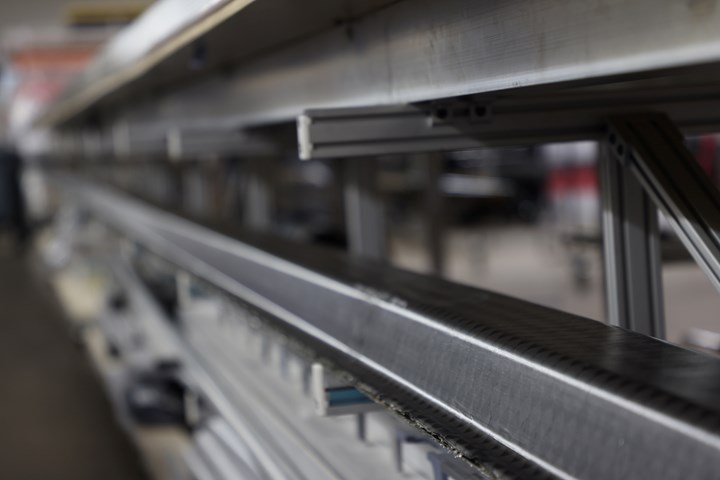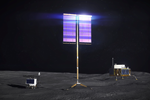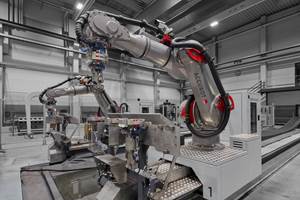
Opterus’ carbon fiber composite booms, like the one shown here, are designed with high strain composites that allow them to fold up for compact storage on a spacecraft. In space, the boom will be unfurled and extended outside the spacecraft as a support structure for other instruments.
Photo Credit, all images: AON3D
Founded in 2015, Opterus Research and Development (Loveland, Colo., U.S.) manufactures highly specialized, deployable spacecraft structures — meaning foldable or bendable components such as reflectors for antennas, solar arrays or booms designed for easy attachment and storage to a satellite or launch vehicle.
The company says the key to high-performance, space-ready structures that are also foldable and compact is its work in pioneering high strain composites (HSC), or composite materials tuned to enable a much higher level of deformation and strain than typical stiffness-driven composite materials. Thanks to HSCs, Opterus claims that some of its deployable structures, which can be up to 30 meters, are capable of rolling out up to 100 times their folded, stowed length.
The company offers a full range of services to its customers, from part design through simulation, analysis, tooling development and low-volume manufacture via oven-cured, aerospace-grade prepregs. Over the past few years, Opterus has added composite 3D printing to its capabilities, with the acquisition of an AON M2+ printer from AON3D (Montreal, Quebec, Canada) in 2019.
Today, Opterus says it uses 3D printing throughout its entire product development life cycle, from concept development to end-use composite parts. “When we’re trying to understand how to design and manufacture these architectures, we really do need to develop early proof-of-concept demonstrations and we leverage a test build process to understand how these advanced structures behave in a space domain,” explains Erik Pranckh, the director of business development at Opterus, in a recent case study video released by AON3D.
The AON M2+ was originally chosen because of its capabilities to print using high-temperature materials, making it suitable for directly printing composite tooling. Opterus designs molds and tools that are then printed using Solvay’s (Brussels, Belgium) Ketaspire PEEK AM Filament CF10 LS1, a carbon fiber-filled polyetheretherketone (PEEK). “A nice feature of the CF PEEK components is the combination of mechanical stability at prepreg cure temperatures coupled with the material’s low CTE [coefficient of thermal expansion], which ensures dimensionally accurate parts after high-temperature processing,” says Eric Beardslee, product and content marketing manager at AON3D.
The M2+ operates via an extrusion-based process, specifically fused filament fabrication (FFF), wherein the printing filament is fed into an extruder head and through a heated nozzle. According to Beardslee, high-performance materials like the carbon fiber-filled PEEK materials that Opterus uses require processing at a constant, high-heat build chamber temperature in order to “maximize mechanical, thermal and chemical properties of a part while reducing printed-in stress and warping.” For this reason, the M2+ operates at high heat — up to 500°C through the nozzle, 135°C in the build chamber and 200°C on the build surface.

This carbon fiber/PEEK mold for a section of a satellite dish was printed via Opterus’ AON M2+ printer. It is shown here being affixed to a larger, machined graphite mold that will be used to manufacture the full-sized satellite.
After printing, an epoxy or Teflon tape can be added to cover up or smooth the layer lines; otherwise, little postprocessing is needed.
The AON M2+ supports a build volume of 450 × 450 × 565 millimeters (approximately 1.5 × 1.5 × 1.9 feet), which suits the needs of much of Opterus’ tooling for deployable space structures. For larger tools, traditional machining of metal or graphite is used.
“The thing that excites me most about what I’m doing here at Opterus is our potential to entirely disrupt the way space structures are designed and disrupt the current state of the art for deployable space structures,” notes Patrick Rodriguez, the composites lead at Opterus.
Related Content
Low-cost, efficient CFRP anisogrid lattice structures
CIRA uses patented parallel winding, dry fiber, silicone tooling and resin infusion to cut labor for lightweight, heavily loaded space applications.
Read MoreCall for abstracts: CW Tech Days to explore high-temperature composite solutions
The fall 2025 installment of CW’s Tech Days online event series will cover high-temperature composite solutions for defense and space applications.
Read MoreAutomated robotic NDT enhances capabilities for composites
Kineco Kaman Composites India uses a bespoke Fill Accubot ultrasonic testing system to boost inspection efficiency and productivity.
Read MoreNew GTL breakthrough in composite tubing for liquid hydrogen in aircraft and space vehicles
Tests versus stainless steel tubing show 10 times faster chill down, fuel flow in 2 seconds and less boil-off for significantly faster fueling and refueling of LH2-powered space vehicles, aircraft and trucks.
Read MoreRead Next
Three companies chosen to advance NASA deployable solar array
Astrobotic Technology, Lockheed Martin and Honeybee Robotics awarded $19.4 million to prototype build and test solar array systems to power moon exploration under Artemis. Current mast designs incorporate carbon fiber-based technologies.
Read MoreComposites end markets: New space (2025)
Composite materials — with their unmatched strength-to-weight ratio, durability in extreme environments and design versatility — are at the heart of innovations in satellites, propulsion systems and lunar exploration vehicles, propelling the space economy toward a $1.8 trillion future.
Read MoreAssembling the Multifunctional Fuselage Demonstrator: The final welds
Building the all-thermoplastic composite fuselage demonstrator comes to an end with continuous ultrasonic welding of the RH longitudinal fuselage joint and resistance welding for coupling of the fuselage frames across the upper and lower halves.
Read More

.jpg;width=70;height=70;mode=crop)





















